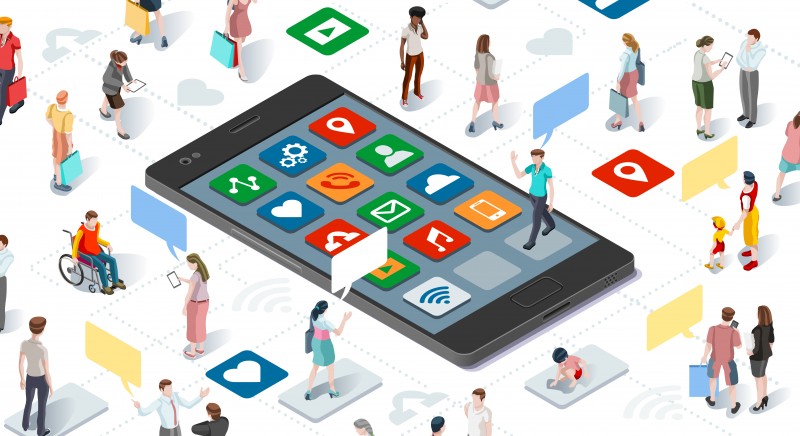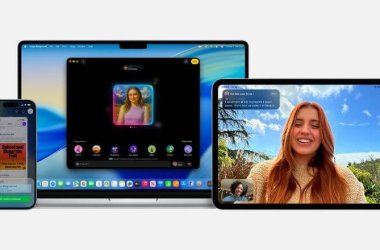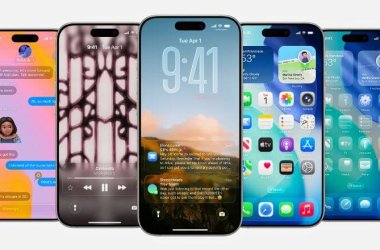Where do apps come from and when did we stop to call them “programmes”? Does your business really need to develop one?

“There’s an app for that.” states the 2009 campaign that pushed the launch of the iPhone 3G. App stands for application and was already in our vocabulary since the late 18th century. It took it until the new millennium to make it famous. In fact, despite the early doubts of many of you on new era phone’s designs and mobile websites (“no physical keyboard?!” “why is flash not implemented?” “Touchscreen?”), APP was the word of the year 2010, according to the American Dialect Society.
This brings us way back but we witnessed the evolution and the use of mobile apps through our always more powerful portable devices, to understand the value of those tiny pieces of software that drain our batteries faster than earth’s rotation.
The App store was launched back in 2008 on iOS, Google play followed some months later. Since then, mobile Apps revolutionised our relationship with almost everything, from games to business, communication, personal interactions, even the way we listen to music or we travel. Along with progress and the Internet Of Things, Apps became the best way to interact with our – always lighter and thinner – devices with the surrounding environment, people or technologies.
If you land here today with a time-machine from the 90’s, you will probably refer to this little standalone as “software programme”. Basically, an App is a piece of software (or self-contained programme as your nerdy friend’s cousin will tell you) that runs a defined number of operations and can communicate externally, if needed.
Different kinds of Apps
So, you decide that you want an App. If you are thinking that a brilliant idea and some coding’s online courses will give you a free access to a lifetime jackpot, you are inevitably going to be very disappointed, my friend.
Instead, start by making yourself the right questions will lead to the right choices. Does your idea or business already have a web presence? Do you (or someone in your team) have experience in programming? What about the design? How do you distribute it? Who are your customers? As a business, you need a web and, moreover, a mobile presence. This is superlatively true if you want your brand or services to stand out.
Data gives us again a clear glance: internet users are 51% of the total population [7.5 Billion], where the average internet user spends almost 4.5 hours per day on the net, 2.5 hours on social media through one of the 3.5 active social media account (more statistics are available on We are Social). The interesting thing is the amount of single mobile users: more than 5 billion.
These mean that 67% of the people are connecting online through a mobile device. Seems that an app would be the best way to access your potential clients. Or is it? How can you reach directly your market’s share? Does your target-customer know your brand?
Now calm down, we can understand that with the necessary information.
Let’s start by identifying the different type of App. There are three main variables to consider: storage, delivery system and compatibility.
- Web App
Data are stored on a remote server that is delivered through the Internet. This App is compatible with any web browser (since it is usually programmed in HTML or javascript framework) and depends on a data connection. Common web Apps are social networks and email services. These particular kinds of applications sanctioned the beginning of the Web 2.0 concept. - Native App
Data are stored locally and it is designed for a specific hardware or device (smartphone, phablet, tablet or wearable). Can interact externally with the web or other Apps. Native Apps will always be faster than web Apps since there is no translation process. On the other side, they are really expensive, especially if you plan to design them for more devices. - Hybrid App
It combines the elements of both, web and native App and it uses a “liquid graphic” that can adapt to multiple format and devices. It can be the best choice in order to reach all the existing stores’ ecosystem, maintaining the budget affordable. But beware! A bad App means bad advertising for your brand. Choose carefully your horses.
Do your business or your idea need an app?
People are online and on their devices. That’s a fact. They use mobile apps. That’s another fact. Do they want to download another one? We don’t think so. We can easily understand if your app is worth the effort.
- Solves a problem
If your app aims to solve a perceived problem it’s a good start. Apps are incredibly simple and can work much faster than websites, especially if you go for the hybrid/native solution. Consider also that there are a lot of Kamasutra, fart-simulator, and currency converter apps. - It’s strictly connected to a product/service
Switch on/off the light, fly your drone, opens your car. If the goal is to give a well-known interface connected to your main product it’s another must for starting an app development. It works for services too, think about banks, e-commerce or insurance. - Entertaining
Video game banks out on app’s stores, and we consider social media app in the entertainment category. Whatever you provide that has to do with gaming or time-losing activity, could work and gain success very fast.
On top of these, consider the risks: we identified 5 main possible issues in app’s development.
- Project’s delivery
Careful in choosing the developer. Analyse whether you want to hire someone internally to follow the development or outsource the project to an external company. Evaluate the candidate and ask specific questions: this requires you to study before… - User experience sucks
You have the features, you have the coder, you have the business model. Don’t forget that “beauty will save the world” and, stupidly enough, it is kind of true. Users need to be happy and enjoy using the app. - Product sucks
And there it comes. Usually, the user experience is the main reason why users don’t use an app, but sometimes the best idea is also the useless one because… people. So, don’t get too much surprised if this happens. - Budget or resources projection
You want it all. You thought it was very easy (you didn’t study, did you?) develop an app with 102 functions, all necessary for the best service. This will certainly lead you to get a huge budget price, that will have to negotiate, reduce the budget, end the money or the resources at half of the project, spend more than double in time and money of the initial price. - Specifications don’t match
If suddenly the product didn’t include those 3 animations that you were sure they understood you wanted them included, maybe a detailed specification was needed ahead. You never saw anyone going to the architect and say “hey, I thought the room inside the house was round! Why you didn’t tell me they were squared?”, right? But it happens in app’s development.
Mobile Websites are also a valid way, with probably less effort in terms of budget and maintenance. Consider how many apps do you use daily and how many of the ones installed on your devices actually solve a problem or a need.
People will reward you if you offer them valuable tools or information. The main question you should answer remains: do you really need an app?





